Description of the Topic
- The Post-9/11 GI Bill influenced veterans’ education rates (Cole & Kim, 2013).
- Veteran students are likely to be first-generation students.
- Military lifestyle affects veterans’ approach to education.
- Campus life and academic assignments pose challenges to veterans.
In 2008, the Post-9/11 Veterans Educational Assistant Act was passed, granting new opportunities for veterans to access higher education. The campuses began receiving an increasing number of veteran students both off and on active duty (Cole & Kim, 2013). This trend is continuing, but colleges and universities still do not have a comprehensive system to accommodate the growing population of veterans.
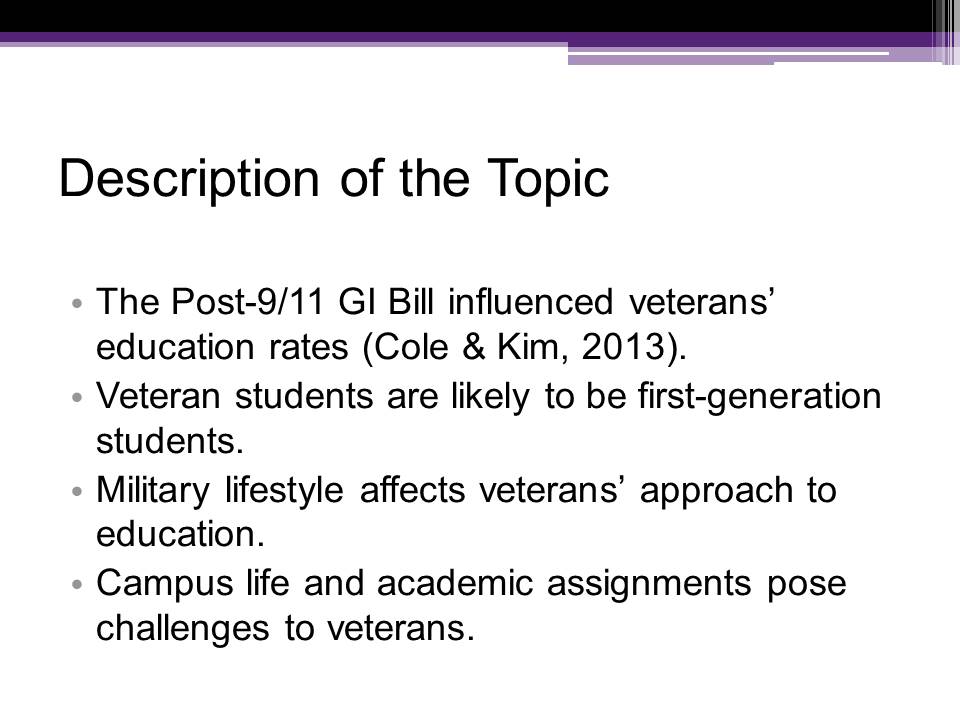
Why It Matters
- In general, research suggests that being a veteran on campus is more difficult than being a civilian on campus.
- Veteran students may benefit from facilitating a smoother transition from military life to student life.
As a result, the latter are encountering challenges as they attempt to integrate into their new role as students. Co-curricular activities show promise for facilitating this integration, suggesting value in conducting a study to investigate whether veteran students’ academic performance can benefit from their participation in co-curricular events. Analyzing the views of student veterans toward education and other social activities can provide some insight into this inquiry.
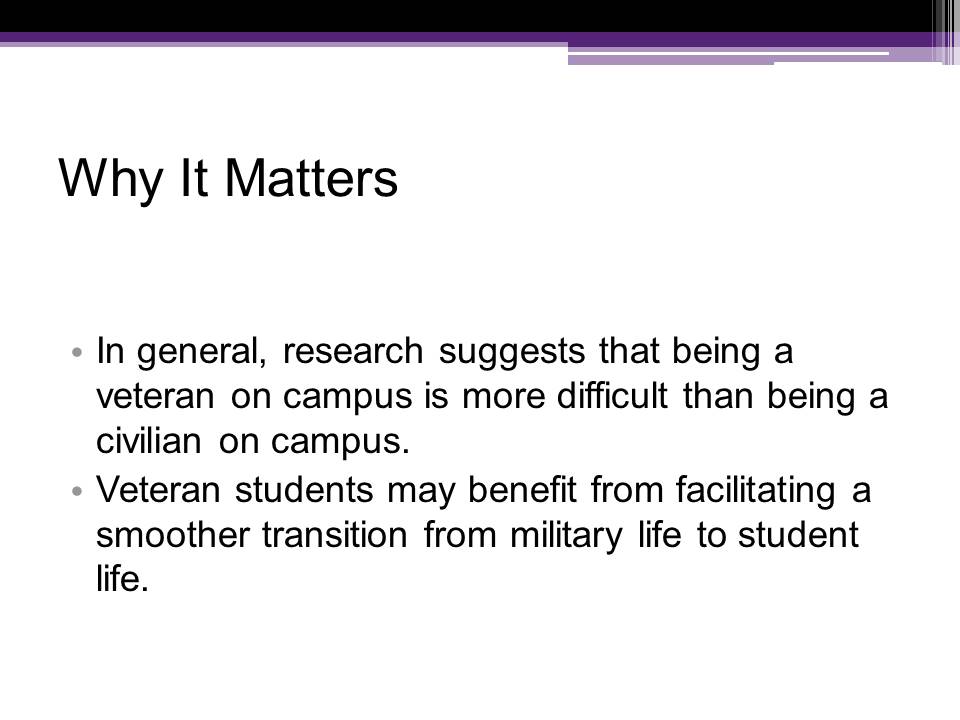
Background Knowledge
- Out of 1 million veterans, more than 75% use their benefits to enroll in postsecondary education (Cole & Kim, 2013).
- Veteran students’ past experiences can serve as a barrier to easy socialization (Grimes et al., 2011).
- Veterans struggle with assuming a new identity as college students (Jones, 2013).
- Student veterans are usually older than 24; they often have families (Grimes et al., 2011).
The use of veterans’ benefits allows military veterans to start or continue their education and receive undergraduate and graduate degrees. Many individuals take advantage of this opportunity; nevertheless, a significant number of them encounter challenges as they seek to assimilate into a new role. While serving in the military, service members lead lives unlike those of civilians (Cole & Kim, 2013). Their view of life’s meaning as well as their everyday activities and thoughts depend substantially on their occupation. When they try to move on to an academic career, veterans perceive a myriad of issues in studying, socializing, and seeking support.

The Development of the Proposed Argument
- Student veterans are less likely to engage with other students in scholarly and co-curricular activities (Cole & Kim, 2013).
- Veterans do not participate in other learning opportunities as often as civilian students (Cole & Kim, 2013)
- Co-curricular activities benefit students’ academic performance and outcomes (Tan & Pope, 2007).
- Collaboration and campus involvement positively affect student life (Frost, Strom, Downey, Schultz, & Holland, 2010).
Former members of the military possess a different set of beliefs and principles that contributes to misunderstandings and separates student veterans from other attendees. Their integration into a new role is negatively impacted by a lack of socialization. According to Tan and Pope (2007), co-curricular activities can solve this problem for many individuals, allowing people to connect through hobbies and personal interests. In this light, an examination of whether the same can be said about the outcomes of student veterans may be salutary.
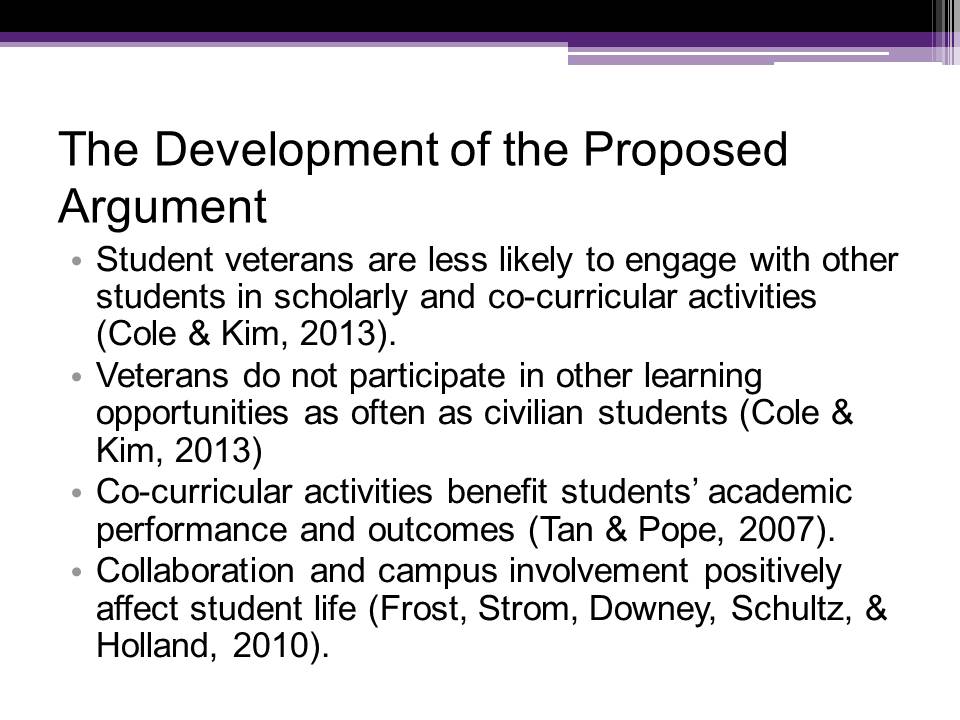
Theoretical Framework
Alexander Astin’s Theory of Student Involvement:
- Students’ involvement in academic activities means investing energy (efforts) in these activities.
The theory behind this research is Alexander Astin’s theory of student involvement. This model is based on the idea that students’ involvement in academic activities is associated with investing their energy in these activities. The higher involvement and engagement in educational programs and co-curricular activities is correlated with higher academic achievements, learning results, and students’ development and performance. Therefore, according to this theory, if educational authorities pay more attention to students’ involvement in different types of activities, including co-curricular ones, it is possible to expect positive outcomes for these students’ academic performance, satisfaction, and intellectual growth (Paulsen, 2017).
According to the theory of student involvement:
- There is a correlation between:
- involvement and engagement in educational programs and co-curricular activities
- students’ higher academic achievements, learning results, development, and performance (Paulsen, 2017).
Depending on this theory, this research will add to understanding the association between students’ involvement in co-curricular activities and their performance with reference to veteran students. The results will contribute to making conclusions regarding generalizing the received findings for a wider student population.
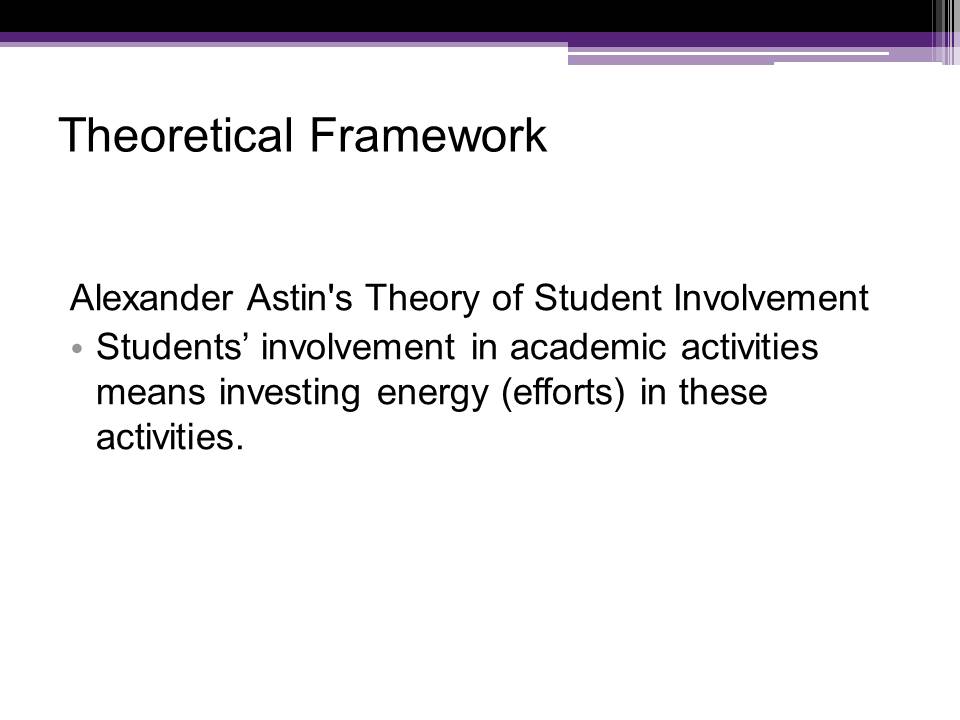
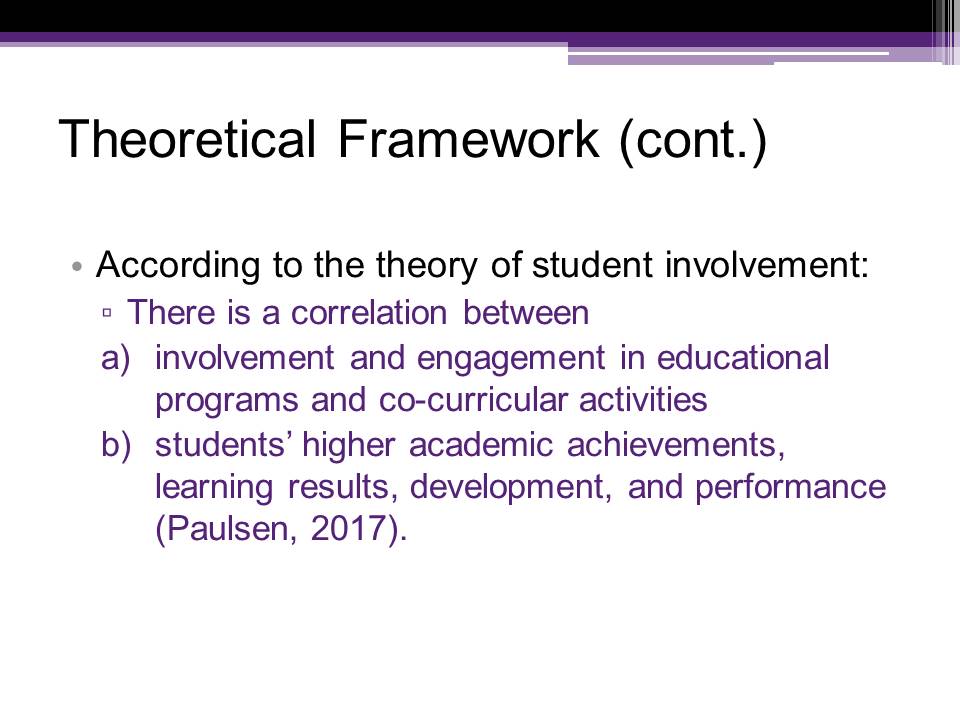
Research Questions
- What do veterans think about academia at the beginning of their education? – Descriptive.
- What are the reasons behind some student veterans’ difficulties in adjusting to student life? – Descriptive.
- Does participation in co-curricular activities improve adjustment or academic performance of student veterans? – Causal.
- Are some activities more beneficial than others? Which aspects make them impactful? – Relational.
The argument of co-curricular activities being beneficial for student performance leads to the development of multiple questions related to veterans. First, the study aims to assess veterans’ general thoughts about academia to understand initially perceived challenges. Next, it is possible to scrutinize the possible causes of some of the issues. Finally, the efficacy of co-curricular activities is the primary subject of the study.
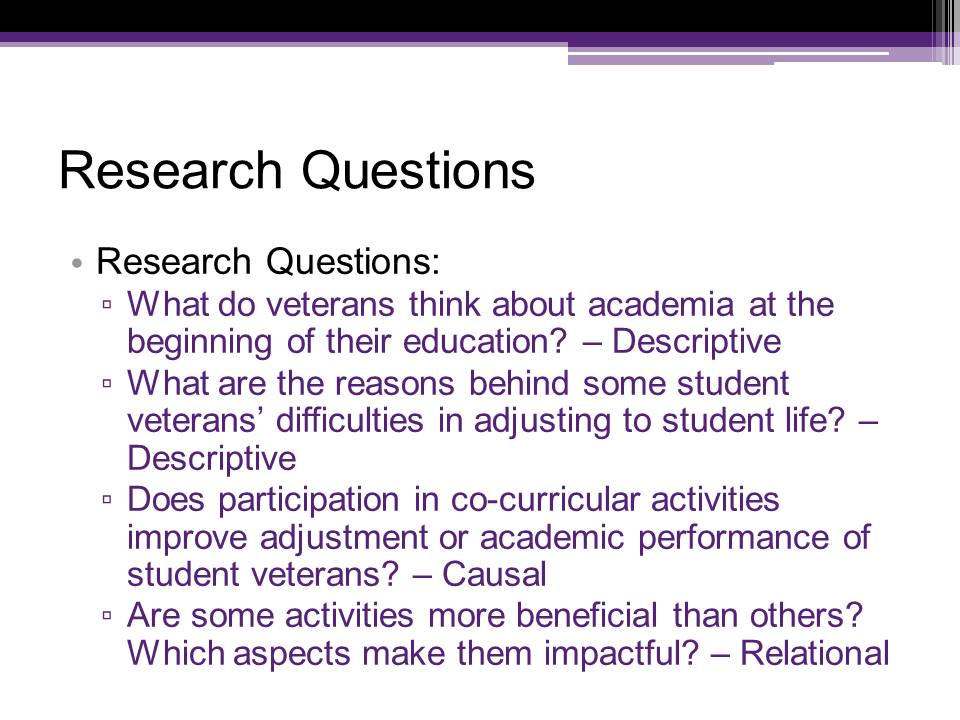
Hypotheses
- Hypothesis 1: Veterans struggle to transition into academic life.
- Hypothesis 2: Participation in co-curricular activities improves adjustment for student veterans.
- Hypothesis 3: Participation in co-curricular activities improves academic performance for student veterans.
The first proposed hypothesis is non-directional, allowing exploration of the possible correlations without set beliefs. Thus, answering the first question will focus on finding whether the posed hypothesis has measurable answers in the search for solutions to the problem of veterans’ adjustment. However, hypotheses 2 and 3 are directional, in that we expect participation in co-curricular activities to have a positive impact on student veterans.
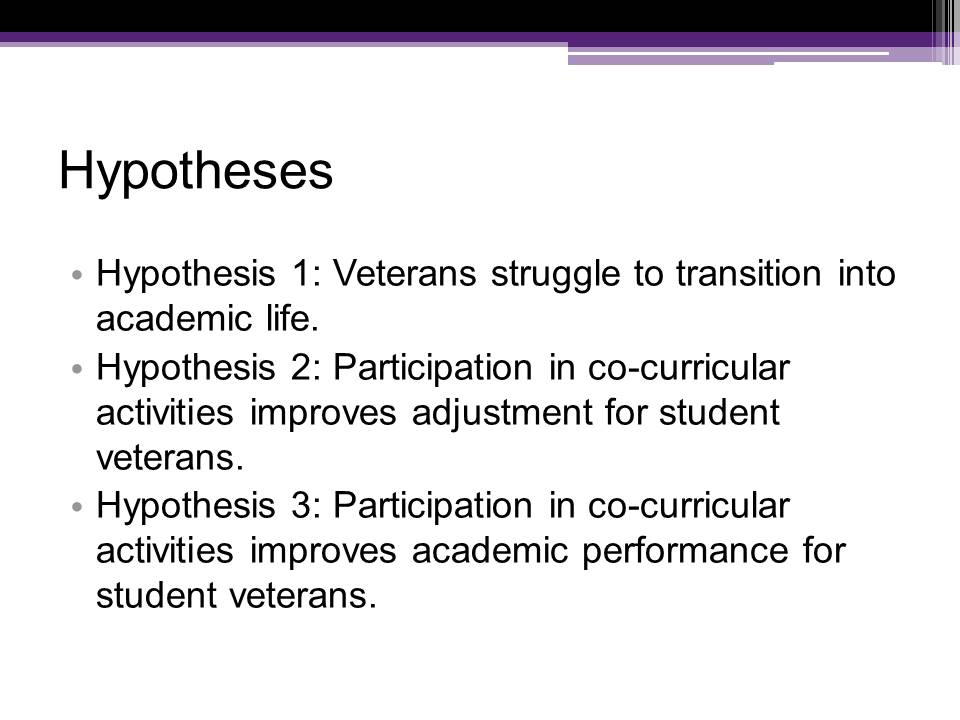
Target Population
Target population: Veteran students.
Student population at UHM includes 1,139 veteran students.
The target population consists of veteran students currently enrolled in educational programs on the campus.

Sample
- Sample – 80 students, 4 groups of 20:
- 1 control group.
- 3 groups engaged in different activities.
- Cluster sampling.
- Inclusion criteria:
- Students with military experience enrolled in a program on campus.
- ▫Veteran, active military, reserve statuses are acceptable.
The required sample is 80 respondents, to be further separated into 4 equal groups. The first group of veteran students is the control – in this group, the participants did not or do not take part in any co-curricular activities. The other 3 groups include students who were engaged in one of three activities such as Latin dancing, group sport (basketball), or gym activity (weightlifting).
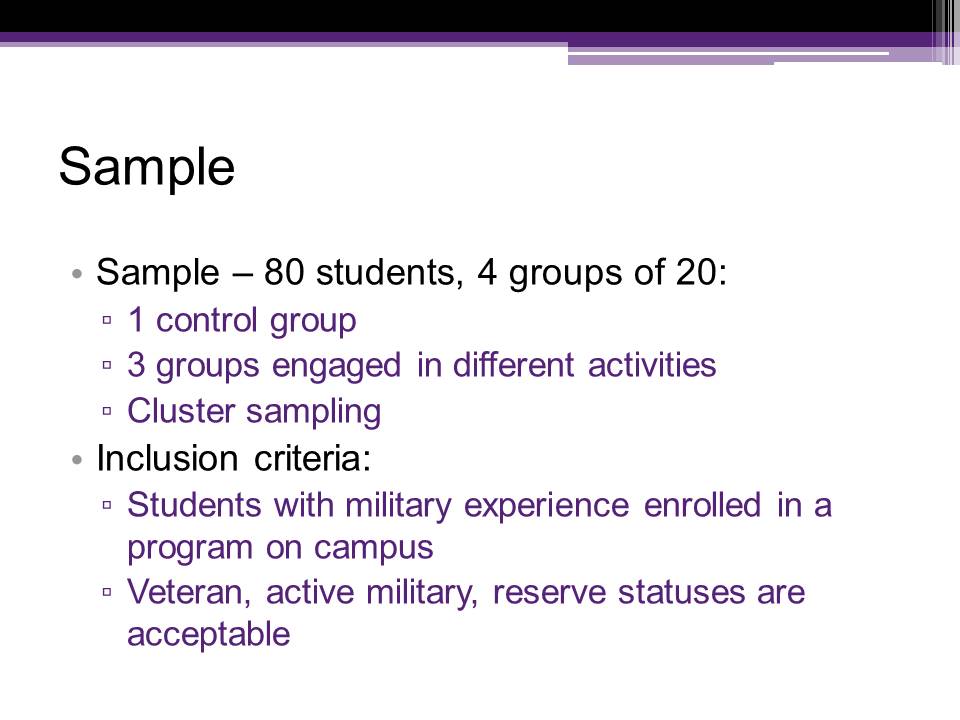
Variables
Independent variable:
- Veteran students’ participation in co-curricular activities.
Measured in the amount of time and effort spent on co-curricular activities according to the ordinal scale.
In this research, the relationship between independent and dependent variables is studied in the context of Hypotheses 2 and 3. The operational definition of the independent variable is the following one: veteran students’ participation in co-curricular activities is the amount of time and effort spent on these activities during the last school term. The ordinal scale is appropriate for measuring and validating this variable. In the student surveys, the independent variable is associated with the question “Please indicate which co-curricular activities (hobbies or pastimes) you participated in within the last school term” and the following two questions (Questions 6-8). These questions allow for collecting data on the time and effort spent by veteran students on different types of co-curricular activities.
Dependent variables:
- Veteran students’ academic performance.
Measured in Grade Point Average (GPA) according to the ratio scale and in Likert scale points according to the ordinal scale .
- Veteran students’ adjustment.
Measured in Likert scale points according to the ordinal scale .
The operational definition of the first dependent variable is the following one: veteran students’ academic performance is measured in GPA as grades provided at the end of the last term and Likert scale points related to students’ perceptions of their academic performance. Veteran students’ adjustment is measured in Likert scale points related to students’ perception of their academic life after separating from the military. Dependent variables in this research are measured and validated with reference to the ordinal and ratio scales. Data about the dependent variables are to be collected through inquiries into students’ opinions about their academic and personal life, competencies, skills, goals, and GPA scores (Questions 9-16 of the survey).
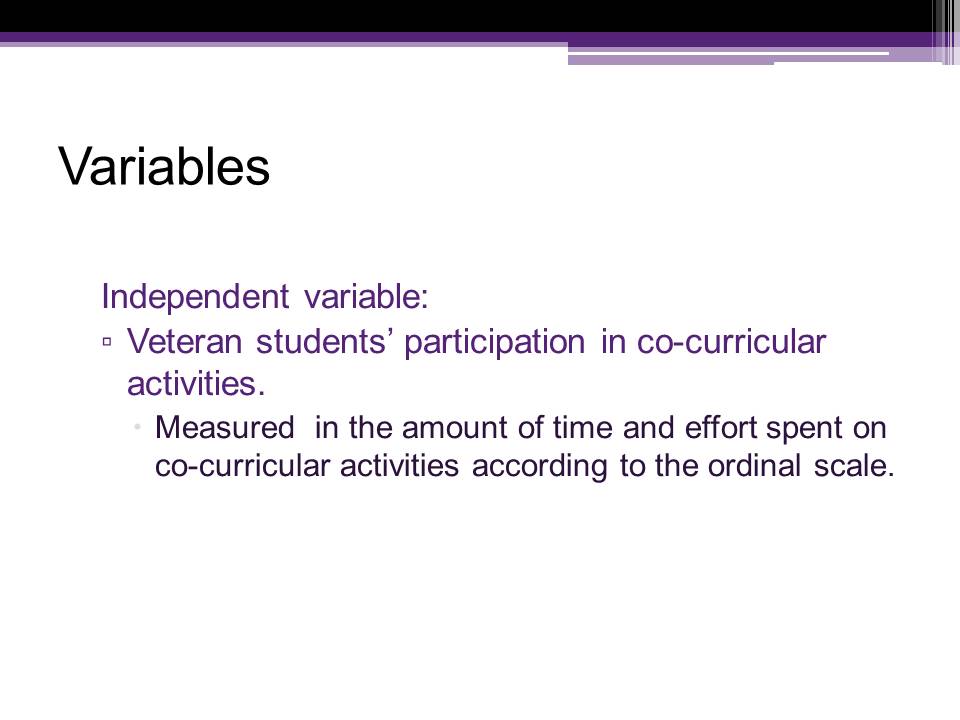
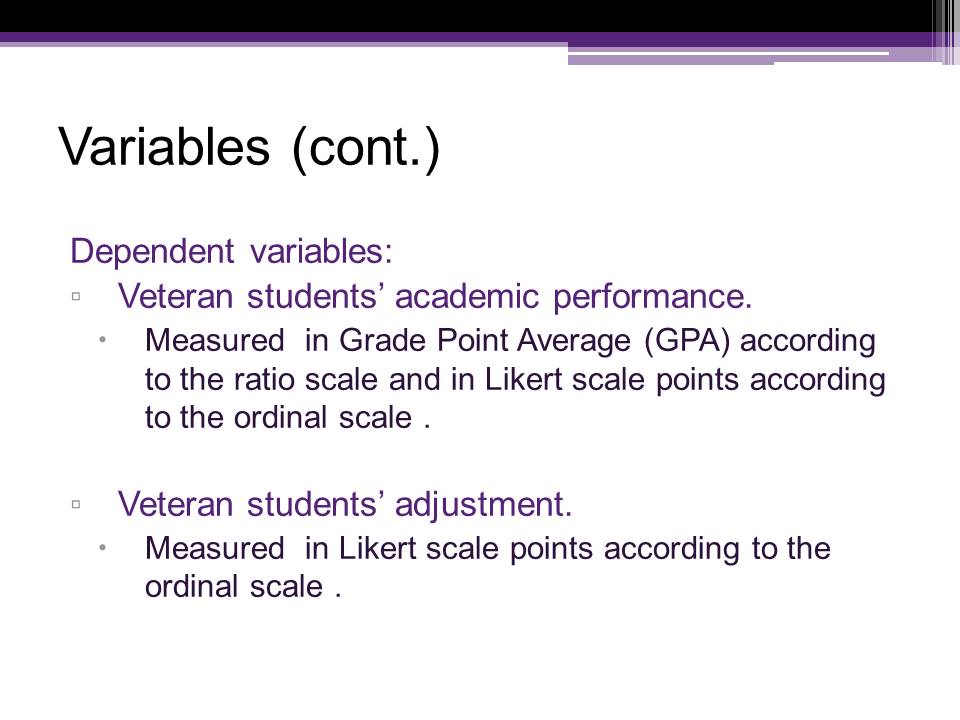
Methodology and Design
Quantitative method
Investigation through statistical evidence.
Quasi-experimental design:
- A within-subjects design is applied.
- Examines the impact of different interventions on multiple groups.
- Uses controlled conditions and quasi-independent variables.
- Has lower internal validity than randomized trials.
The study aims to use a quasi-experimental design that will employ four different groups of participants because of avoiding the random assignment of participants to different groups. A within-subjects design is selected because all participants receive the same stimulus related to co-curricular activities. This design is quantitative in nature, meaning that data will be collected and measured to provide statistical evidence. The sampling method and the separation of participants into groups are purposeful, reflecting the necessity of inter-group comparison. Numbers collected in a non-randomized setting are easier to control and measure, although they are subject to concerns in terms of internal validity, including biases toward or against some activities (social interaction, frequency, effect). These threats are addressed with cluster sampling and control group measures as well as tests to be described further.
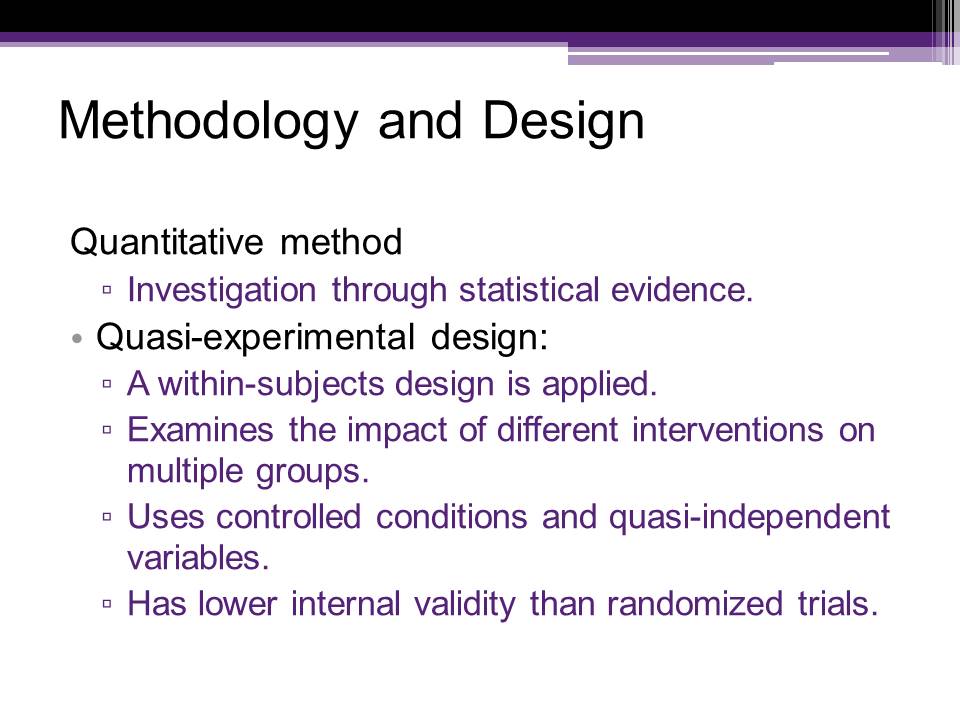
Rationale of Quantitative Data Collection
A quantitative design was chosen to suggest a correlation between students’ activities and performance. The use of a cross-sectional quasi-experimental approach allows the exploration of different research questions without relying on a single concrete hypothesis, thus lowering the control over the environment and limiting bias. The necessity to use a quantitative design lies in the statistical (ergo, measurable) nature of all posed questions. Such studies as Close and Kim (2013) demonstrate the benefits of using a quantitative model – they reveal observable challenges of veteran students and provide data that can be used to strive for improvement. Moreover, a lack of quantitative research exploring the effects of co-curricular activities on veteran students’ integration is evident, while many qualitative studies exist (Grimes et al., 2011; Jones, 2013; Semer & Harmening, 2015; Vacchi, 2012).
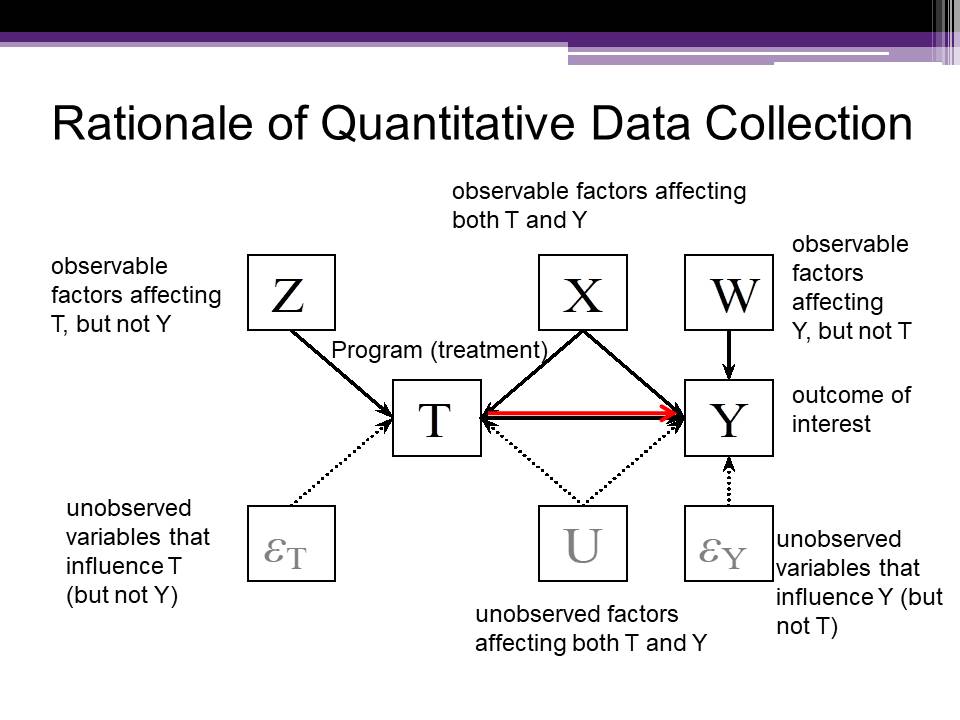
Data Analysis
- Collection of survey results:
- Nominal: engagement in hobbies (yes/no), types of co-curricular activity, demographic information (gender, relationship status, employment status, and other)
- Ordinal: activity frequency, impacts of participation, personal and academic competences (from 1 to 5)
- Ratio: GPA scores.
The survey’s results present different sets of data that can be used in the study. First, the demographic information (gender, level of education, employment status, and other factors) are examples of nominal data where different measures cannot be estimated in relation to each other. These will be analyzed using descriptive statistics. Ordinal data such as scales from one to five constitute the results of students’ self-evaluation. In this case, these answers are numbered, but they do not have any specific, measurable differences between them. Finally, the GPA of students is the only ratio measurement collected from surveys.
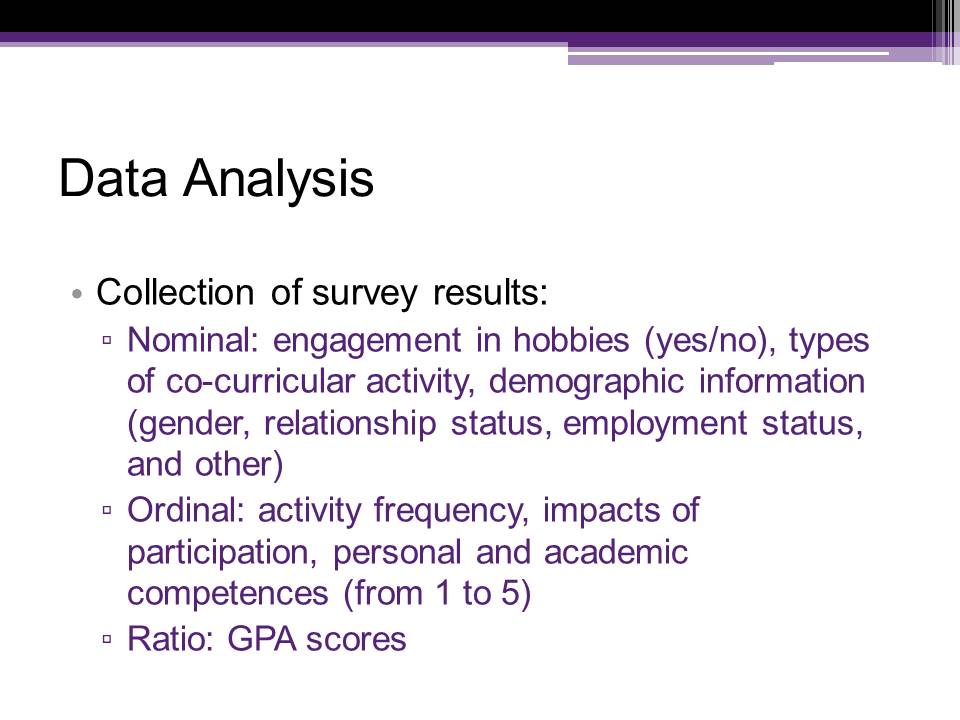
Data Interpretation and Limitations
- Shapiro-Wilk test for normality of distribution.
- Simple descriptive statistics for demographic data presentation.
- ANOVA for statistical significance of group differences.
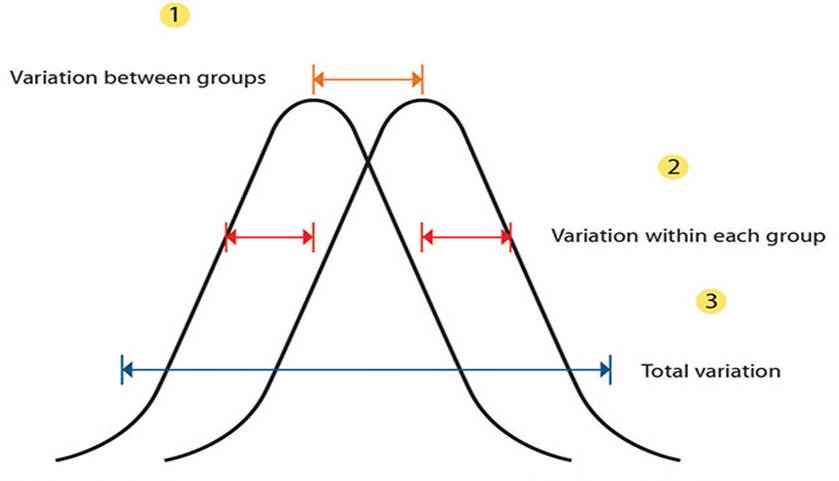
The assumptions of normality will be tested using the Shapiro-Wilk test. If the received value is higher than 0.05, the data can be considered as normal to continue testing while using ANOVA. Demographic data will be analyzed and presented using descriptive statistics. For chi-squared and ANOVA tests, the null hypotheses will consider that correlations between academic performance/personal competencies and participation in co-curricular activities do not exist. Furthermore, the variation between groups will be measured as well using the ANOVA test (Image 1). The confidence interval is 95%, margin of error under 10%. In this case, the non-parametric version of ANOVA is used to operate the data measured according to the ordinal scale. The similar research was conducted by Ritchie (2018) who applied the regression analysis using SPSS software in order to determine how co-curricular activity participation of students could influence their academic performance with the focus on measuring this participation and GPA.
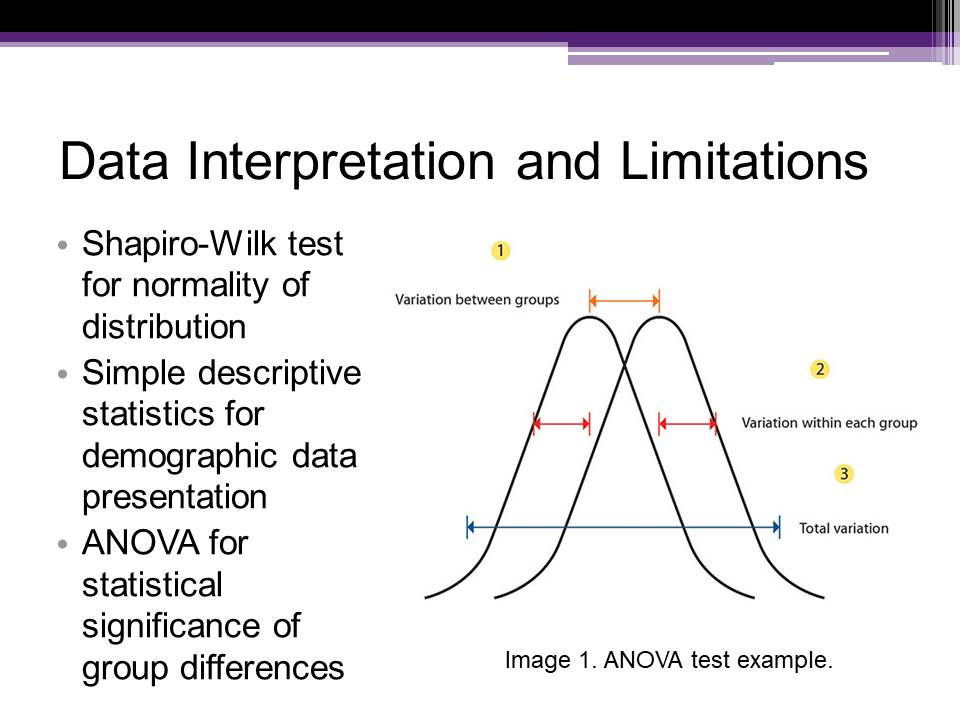
Validity and Reliability
- Threats to internal validity:
- There is a high likelihood that other alternative explanations for findings can be found.
- Reliability issues:
- The possibility to repeat the study is limited by the selection of participants and their assignment to groups.
- To address the threats:
- Applying a control group;
- Formulating hypotheses to avoid alternative explanations;
- Avoiding the measurement bias using ordinal scales and SPSS software.
Quasi-experimental quantitative research designs are associated with threats to internal validity. The reason is that there is a high likelihood that any other alternative explanation for findings can be found. There are also issues associated with reliability because the possibility to repeat the study is limited by the selection of participants and their assignment to groups. To address these threats, the researcher will focus on design controls and apply a control group and concentrate on formulating hypotheses to avoid alternative explanations. To avoid the measurement bias, the researcher has selected ordinal scales for the variables and the application of SPSS software for data analysis.
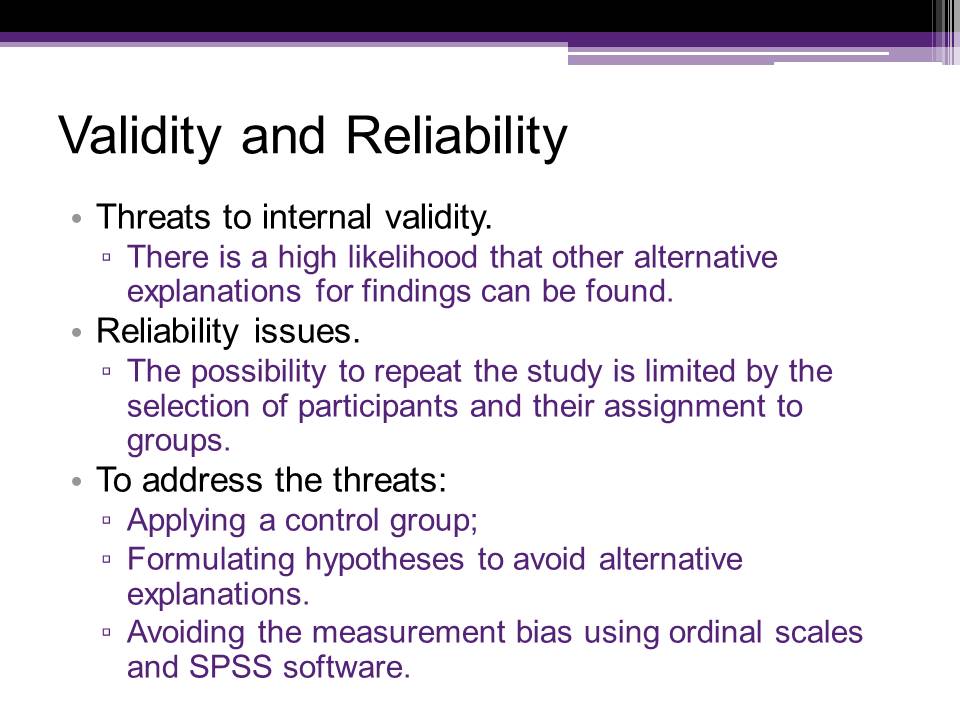
Expected Results
- A positive correlation exists between participation in co-curricular activities and student performance.
- Co-curricular activities impact student social life.
- Co-curricular activities benefit academic performance.
- Students engaged in group activities (dancing, basketball) report easier interaction with peers.
The expected results should provide answers to all posed research questions. For example, the collected data should reveal any existing correlation between co-curricular activities and student performance. It is assumed that some differences between the control group and other participants will be revealed in relation to their social life, view of personal goals, and other parameters. The possibility of seeing particular effects of various co-curricular activities such as dancing and basketball on people’s interaction with other students may also be anticipated. The results of this study should provide some insight for future research regarding veteran student programs.
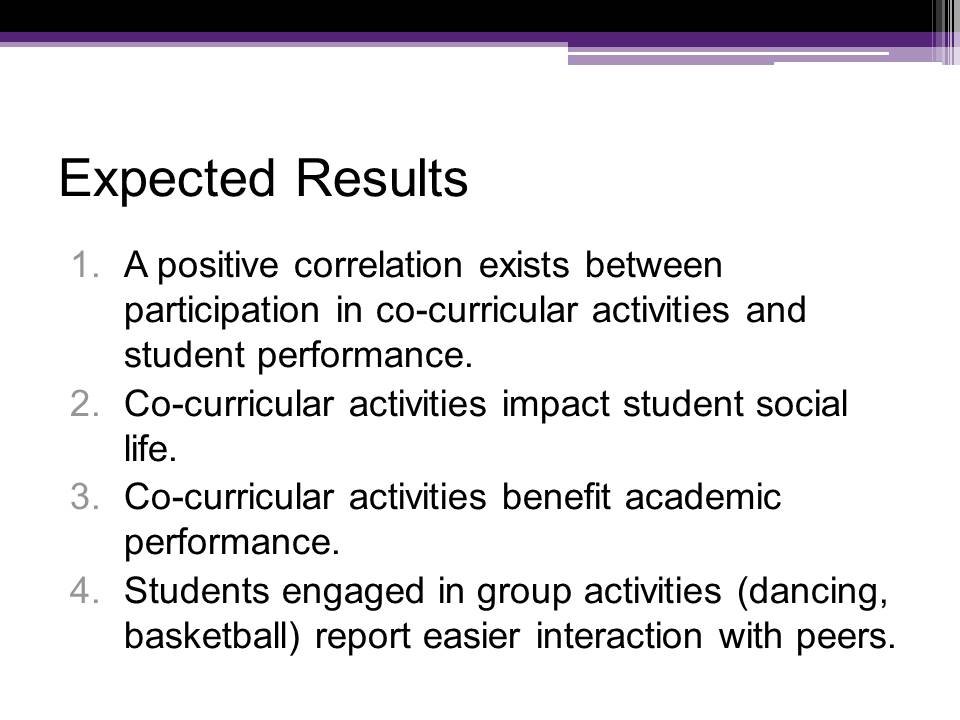
References
Cole, J. S., & Kim, Y. M. (2013). Student veterans/service members’ engagement in college and university life and education. Washington, D.C.: American Council on Education.
Frost, R. A., Strom, S. L., Downey, J., Schultz, D. D., & Holland, T. A. (2010). Enhancing student learning with academic and student affairs collaboration. The Community College Enterprise, 16(1), 37-51.
Grimes, A., Meehan, M., Miller, D., Mills, S. E., Ward, M. C., & Wilkinson, N. P. (2011). Beyond the barricade: A holistic view of veteran students at an urban university. Journal of the Student Personnel Association at Indiana University, 62-74.
Jones, K. C. (2013). Understanding student veterans in transition. The Qualitative Report, 18(37), 1-14.
Paulsen, M. B. (Ed.). (2017). Higher education: Handbook of theory and research. New York, NY: Springer.
Ritchie, G. M. (2018). The impact of academic co-curricular activity participation on academic achievement: A study of Catholic high school students. Web.
Semer, C., & Harmening, D. S. (2015). Exploring significant factors that impact the academic success of student veterans in higher education. Journal of Higher Education Theory & Practice, 15(7), 31-43.
Tan, D. L., & Pope, M. L. (2007). Participation in co-curricular activities: Nontraditional student perspectives. College and University, 83(1), 2-9.
Vacchi, D. T. (2012). Considering student veterans on the twenty-first-century college campus. About Campus, 17(2), 15-21.